History l Pictures and storys from September 2005
9
April - the German invasion of Norway
Early morning on 9 April 1940, a total of 58 ships and 8,850 men attacked
Norway at six key locations. One of these was Narvik, led by Captain Friedrich
Bonte onboard the destroyer Wilhelm Heidkamp.
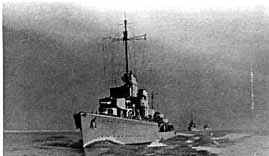 Ten
German destroyers were involved in the operations around Narvik, and at
04:15 one of the squadrons came across the Norwegian ironclad PS Eidsvold
at the entrance to Narvik harbour. An officer from Wilhelm Heidkamp was
sent by boat to persuade the Norwegian Captain to surrender in peace,
but the attempt was refused. Wilhelm Heidkamp opened fire as soon as the
German officer had left the Norwegian ship, and PS Eidsvold sunk after
a few seconds, killing 175 men.
Ten
German destroyers were involved in the operations around Narvik, and at
04:15 one of the squadrons came across the Norwegian ironclad PS Eidsvold
at the entrance to Narvik harbour. An officer from Wilhelm Heidkamp was
sent by boat to persuade the Norwegian Captain to surrender in peace,
but the attempt was refused. Wilhelm Heidkamp opened fire as soon as the
German officer had left the Norwegian ship, and PS Eidsvold sunk after
a few seconds, killing 175 men.
Eidsvold's sister ship, the ironclad PS Norge, met the same fate just a few minutes later when she was torpedoed by the German destroyer Bernd von Arnim, killing 101 men. The Germans went ashore without any resistance from the Norwegian garrison, and quickly occupied several strategic positions in Narvik.
10 April - the first
battle
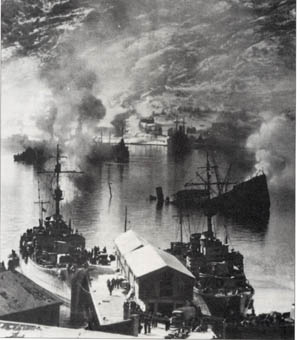 When the news of the German landings in Norway reached London and Paris
on the morning of 9 April, the War Cabinet in London decided to mount
an immediate operation to recapture Narvik.
When the news of the German landings in Norway reached London and Paris
on the morning of 9 April, the War Cabinet in London decided to mount
an immediate operation to recapture Narvik.
Early morning on 10 April the British 2nd Destroyer Flotilla commanded by Captain Bernard Warburton-Lee entered the Ofotfjord. Thanks to bad weather and heavy snowfall, the five destroyers led by HMS Hardy managed to reach Narvik unnoticed. The Germans were not expecting the sudden attack, and two of the five German destroyers anchored in the harbour were torpedoed and sunk, whilst the three others were heavily damaged. The British also sunk six merchant ships in the crowded harbour.
On the way back toward the mouth of the fjord, the British fleet met the five German destroyers that had been placed in the neighbouring fjords during the night. Two of the British destroyers were lost and Warburton-Lee died during the battle. He received the Victoria Cross posthumously.
British losses:
HMS Hardy
HMS Hunter
HMS Hotspur (damaged)
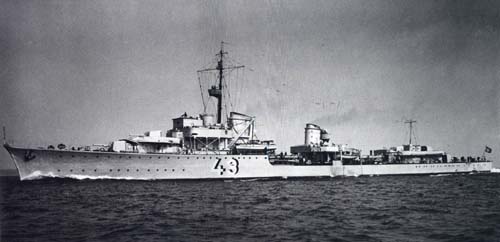
German losses:
Anton Schmitt
Wilhelm Heidkamp
Dieter von Roeder (damaged)
Bernd von Arnim (damaged)
Hans Lüdeman (damaged)
Herman Künne (damaged)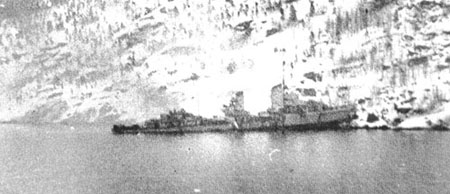
Georg Thiele (damaged, shown above))
Merchant ships sunk
in Narvik harbour:
Romanby (GB)
Blythmoor (GB)
Neuenfels (DE)
Martha Hendrik Fisse (DE)
Saphir (NO)
Cate B (NO)
13 April - the second
battle
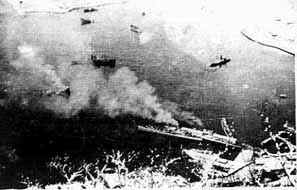 The Second Battle of Narvik started noon on the 13 April, preceded by
an air strike from the carrier HMS Furious the day before. The British
fleet consisted of nine destroyers and the battleship HMS Warspite, under
command of Vice Admiral Whitworth.
The Second Battle of Narvik started noon on the 13 April, preceded by
an air strike from the carrier HMS Furious the day before. The British
fleet consisted of nine destroyers and the battleship HMS Warspite, under
command of Vice Admiral Whitworth.
The German destroyer Erich Koellner was torpedoed by HMS Bedouin and HMS Eskimo while trying to hide in Djupvik. In Narvik harbour Erich Giese got torpedoed whilst Dieter von Roeder got scuttled by the crew after heavy attacks.
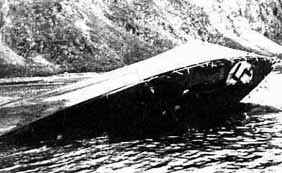 HMS
Eskimo and three other destroyers followed the remaining German destroyers
into the Rombaksfjord. Empty of ammunition, the Germans scuttled all the
ships and the crew escaped ashore to later join the German forces in Narvik.
HMS
Eskimo and three other destroyers followed the remaining German destroyers
into the Rombaksfjord. Empty of ammunition, the Germans scuttled all the
ships and the crew escaped ashore to later join the German forces in Narvik.
(The pictures shows the Destroyer George Thiele after the war)
Admiral Whitworth and the British Navy now had full control over the Norwegian fjords, but evaluated the risk of an on-land operation in Narvik too high. Several German submarines were expected to be in the area, and about a dozen German airplanes had been spotted. They decided to withdraw from Narvik the next day.

British losses:
2 Swordfish bombers
German losses:
Erich Giese (Narvik harbour)
Dieter von Roeder (Narvik harbour)
Erich Koellner (the Ofotfjord)
Herman Künne (the Herjangfjord)
Bernd von Arnim (the Rombaksfjord)
Hans Lüdeman (the Rombaksfjord)
Georg Thiele (the Rombaksfjord)
Wolfgang Zenker (the Rombaksfjord)
U-64 (submarine)
Merchant ships sunk
in Narvik harbour:
Apart from the German supply ship Jan Wellem, all the remaining merchant
ships in the harbour were torpedoed.
See the pictures, taken in September 2005